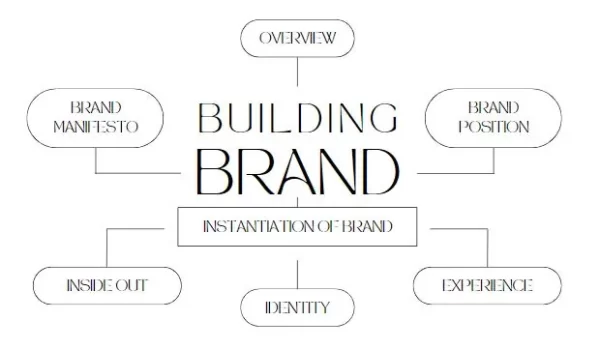Brand creation: Whether you own a small business or operate a larger organization, branding is essential to establishing a presence in your market and keeping customers coming back for more.
Businesses that have a clear brand are easier to remember and recognize; they’re also more likely to inspire loyalty from customers. Even if you don’t plan on expanding your business or entering new markets in the near future, creating a brand is an important step toward long-term success.
How do you begin the process of creating your company’s brand? There are many different factors that need to be considered as you move forward with the design. Keep reading to learn more about the benefits of creating a brand and how it will ultimately benefit your business as well as future expansion opportunities.
Frequently asked questions.
Do small businesses need branding?
Yes, small businesses can benefit greatly from branding. Branding helps establish your business’s identity, differentiates your products or services from those of your competitors, and builds customer loyalty. A strong brand can also make it easier to attract new customers and increase the value of your business over time.
In today’s competitive business environment, even small businesses need to create a strong and recognizable brand in order to succeed. This can include developing a logo, tagline, and other visual elements that help define your brand, as well as crafting a consistent message and tone for your marketing materials.
Branding can also help small businesses establish credibility and gain the trust of customers and other stakeholders. By taking the time to develop a strong brand, small businesses can increase their chances of success and position themselves for long-term growth.
What are the 4 steps of branding?
Research and Analysis: Conduct market research to understand your target audience, competition, and industry trends. This information will inform the development of your brand strategy and messaging.
Brand Development: Develop the visual and messaging elements of your brand, including your logo, tagline, and brand personality. These elements should be consistent across all touchpoints and reflect your unique value proposition.
Brand Implementation: Roll out your brand across all of your marketing and communications materials, including your website, social media profiles, advertising, and packaging.
Brand Management: Continuously monitor and measure the effectiveness of your brand and make adjustments as necessary. This includes regularly updating your messaging, visuals, and other elements to ensure they remain relevant and consistent with your brand.
By following these steps, you can develop a strong and effective brand that differentiates your business from competitors, builds customer loyalty, and supports long-term growth.
What are the 3 C's of branding?
Clarity: A clear brand message and purpose that clearly communicates what your business stands for and what makes it unique.
Consistency: Consistent messaging and visual elements across all touchpoints, from your website to your advertising to your packaging.
Connections: Building emotional connections with your target audience through consistent messaging, storytelling, and experiences that resonate with their values and needs.
By focusing on these three elements, you can create a strong and recognizable brand that differentiates your business from competitors, builds customer loyalty, and supports long-term growth.
What is a Brand?
A brand is more than just a logo or a name. It’s the emotional response that a customer has to a company’s products or services. A strong brand can differentiate your business from the competition and build customer loyalty.
There are a few key things you can do to turn your business into a brand.
First, you need to clearly define what your brand is and what it stands for. Once you have a clear understanding of your brand, you need to be consistent in everything you do. Your branding should be evident in your marketing materials, your website, and the way you interact with your customers. You also need to be aware of what your competitors are doing and position your brand accordingly. By taking these steps, you can turn your business into a brand that customers will remember.

An overview while building a brand is a summary of the key elements and steps involved in creating a successful brand. It should cover the following aspects:
Brand Strategy: The purpose and direction of your brand, including your mission, values, target audience, and unique selling proposition (USP).
Research and Analysis: Understanding your target audience, competition, and industry trends to inform the development of your brand.
Brand Identity: The visual and messaging elements that make up your brand, including your logo, tagline, and brand personality.
Brand Implementation: Rolling out your brand across all of your marketing and communication materials, including your website, social media profiles, advertising, and packaging.
Brand Management: Continuously monitoring and measuring the effectiveness of your brand and making adjustments as necessary to ensure consistency and relevance over time.
By following these steps and incorporating these key elements, you can create a strong and effective brand that differentiates your business from competitors, builds customer loyalty, and supports long-term growth.
A brand manifesto is a statement that outlines the values, beliefs, and purpose of a brand. It serves as a guiding principle for the brand and helps to define its identity, direction, and culture. A brand manifesto typically includes the following elements:
Mission: A clear statement of the brand’s purpose and goals.
Values: The beliefs and principles that the brand stands for and that guide its decisions and actions.
Unique Selling Proposition (USP): The aspect of the brand that sets it apart from competitors and defines its competitive advantage.
Customer Promise: The promise made to customers about what they can expect from the brand in terms of products or services, quality, and customer experience.
Personality: The unique personality and tone of the brand, which should be reflected in its messaging and visual elements.
Story: The narrative of the brand and how it relates to its customers, employees, and stakeholders.
A brand manifesto is an important tool for creating consistency and clarity in the branding process and for communicating the brand’s identity to stakeholders, including employees, customers, and partners. By clearly articulating its values, beliefs, and purpose, a brand manifesto helps to build a strong and distinctive brand that resonates with its target audience and supports long-term growth.
Brand position:
This is the place a brand occupies in the minds of its target audience compared to its competitors. It is how a brand is perceived in relation to its competitors and is shaped by a number of factors, including product features and benefits, price, quality, and reputation. A brand’s position is a key driver of its success and is often shaped by its marketing and branding efforts, including advertising, packaging, and messaging.
The goal of brand positioning is to create a distinct image in the minds of consumers that sets the brand apart from its competitors and resonates with the target audience. A well-defined brand position can help to increase brand recognition and recall, build customer loyalty, and drive sales and revenue.
To develop a strong brand position, it’s important to understand the target audience and their needs, as well as the competitive landscape. This information can be used to identify opportunities
Instantiation:
Instantiation in branding is the act of making a brand tangible, by giving it physical form through various mediums such as logos, packaging, advertising, products or services. This process helps bring a brand to life and make it more meaningful to consumers. The goal of instantiation is to establish a consistent and recognizable image for the brand across all customer touchpoints, making it easier for customers to identify and remember the brand. Through effective instantiation, a brand can create a strong visual identity and build a connection with its target audience.
Inside-out:
“Inside-out” branding refers to a brand building approach that starts with understanding and defining the values, mission, and culture of an organization, and then extends that identity to the customer-facing elements of the brand such as products, services, and communications.
This approach emphasizes the importance of building a strong, authentic brand from the inside out, by aligning the internal culture and values of the organization with the brand’s messaging and identity. By creating a consistent brand experience both internally and externally, organizations can create a strong brand image and foster trust and loyalty with their customers.
An inside-out approach to branding helps organizations create a unified brand identity that is genuine and meaningful, and reinforces the brand’s values and purpose in all customer interactions.
Identity:
Identity in branding refers to the unique and defining characteristics that distinguish a brand from others and set it apart in the minds of consumers. It encompasses elements such as the brand’s name, logo, tagline, tone of voice, and visual style.
A strong brand identity helps a company establish a clear and consistent image, making it easier for consumers to recognize and remember the brand. It also helps to communicate the brand’s values, personality, and promise to customers, and to differentiate the brand from its competitors.
The development of a brand identity involves a deep understanding of the target audience, the brand’s unique value proposition, and the competitive landscape. Effective branding strategies focus on creating a clear, memorable, and consistent brand identity that resonates with the target audience and sets the brand apart from its competitors.
Experience:
Experience in instantiation in branding refers to the total sum of all interactions a customer has with a brand, including their emotional and sensory reactions, as well as their perceptions and attitudes towards the brand. The goal of instantiation in branding is to create a consistent and positive experience for customers across all touchpoints, such as advertising, packaging, products, services, and customer service.
A well-designed brand experience can play a significant role in building brand loyalty and creating a positive emotional connection with customers. It can also set the brand apart from its competitors, and increase the likelihood that customers will choose the brand over others.
Instantiation in branding is about creating tangible expressions of a brand’s identity that are designed to evoke specific emotions, attitudes, and perceptions in customers. By designing a brand experience that is consistent, meaningful, and positive, companies can create a powerful connection with their customers and build a strong and recognizable brand.
Why is Branding Important?
Branding is important for businesses for many reasons. First, it helps businesses to create a unique identity. A strong brand can make a business more recognizable, which can help to attract new customers. Branding can also help businesses to build customer loyalty, as customers are more likely to continue doing business with a brand they trust and recognize. Additionally, branding can help businesses to charge higher prices for their products or services, as customers are often willing to pay more for a product or service from a brand they know and trust. Ultimately, branding can help businesses to be more successful and profitable.
Tips for Turning Your Business into a Brand
When it comes to brand creation, there are a few key steps to take in order to turn your business into a brand. Firstly, in the process of brand creation, you need to establish what your brand is and what it stands for. This means defining your mission, values, and USP (unique selling proposition). Once you have these key elements in place, the next step in brand creation is to start thinking about how you can communicate your brand to your target audience. This involves creating a strong and recognizable visual identity, as well as developing key messaging that will resonate with your target market. By following these steps in brand creation, you can effectively turn your business into a strong and recognizable brand.
It’s also important to ensure that your brand is consistent across all touchpoints, from your website and social media channels to your physical collateral and customer service. This means using the same logo, colors, and tone of voice across all platforms. Consistency will help to solidify your brand in the minds of your target audience and make it more recognizable.
Finally, you need to think about how you can make your brand stand out from the competition. This might involve differentiating your products or services, or it could simply be about having a stronger and more recognizable brand identity. Whatever approach you take, make sure that you are intentional about it and that it aligns with your brand values.
As the owner of a small business, you may be wondering how you can turn your business into a brand. After all, big businesses have all the resources to create a strong brand identity, while you may be struggling to get your business off the ground.

Luckily, there are a few simple steps you can take to turn your business into a brand.
- Create a strong visual identity: Your visual identity is one of the most important aspects of your brand. Because it is the first thing that potential customers will see. Make sure your logo is simple, memorable, and relevant to your business. Choose colors that reflect your brand’s personality, and use them consistently across all of your marketing materials.
- Develop a unique selling proposition: What makes your business different from your competitors? What can you offer that they can’t? Answering these questions will help you to develop a unique selling proposition (USP). This will be a key part of your branding strategy, as it will help you to stand out from the crowd.
- Create customer loyalty programs: Customer loyalty programs are a great way to encourage customers to keep coming back to your business. Offer rewards for repeat business, such as discounts or freebies. You could also create a loyalty card system, where customers can earn points every time they make a purchase.
- Focus on delivering a great customer experience: Your brand is nothing without happy customers, so it’s important to focus on delivering an exceptional customer experience. Every interaction
- Build a strong online presence: In today’s digital world, it’s important to have a strong online presence. Make sure your website is optimized for search engines, and that it is mobile-friendly. Social media is also a great way to connect with potential and existing customers.
5 inexpensive branding ideas.
Here are five tips for inexpensive ways of brand creation:
Develop a clear and concise brand message: Define what your business stands for and what makes it unique, and make sure this message is consistent across all of your marketing materials.
Utilize social media: Create profiles on popular social media platforms and use them to engage with customers and build your brand.
Network with other businesses: Collaborate with other businesses in your industry to build relationships and increase brand exposure.
Leverage word-of-mouth marketing: Encourage satisfied customers to spread the word about your business to their friends and family.
Invest in high-quality business cards and other printed materials: Professional-looking business cards and marketing materials can help establish credibility and make a positive impression on potential customers.
By following these tips, small businesses can effectively build their brand without breaking the bank. It’s important to remember that branding is an ongoing process and to be consistent in your messaging and visual elements over time to build a strong and recognizable brand.
Conclusion
Do not confuse a logo with a brand, a brand is much more than a name or logo. It’s the sum total of how customers perceive your business, and it encompasses everything from the products and services you offer to the way you deliver them. Creating a strong brand is essential to the success of any business, and it starts with understanding what a brand is and how to create one.



